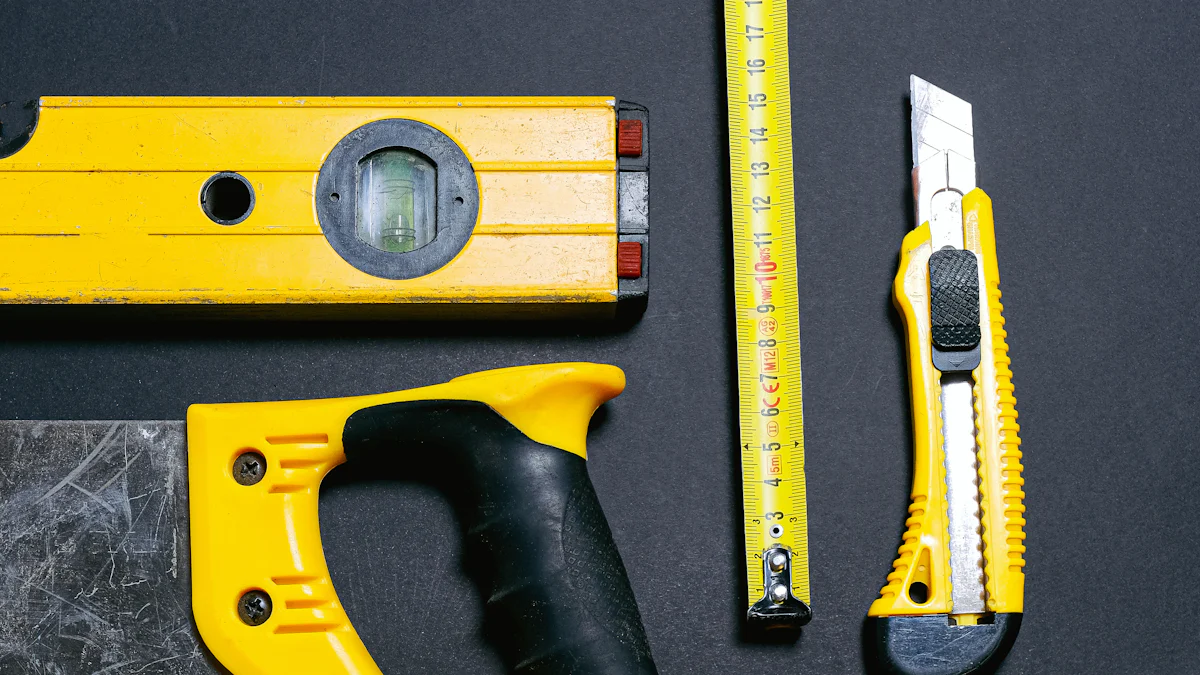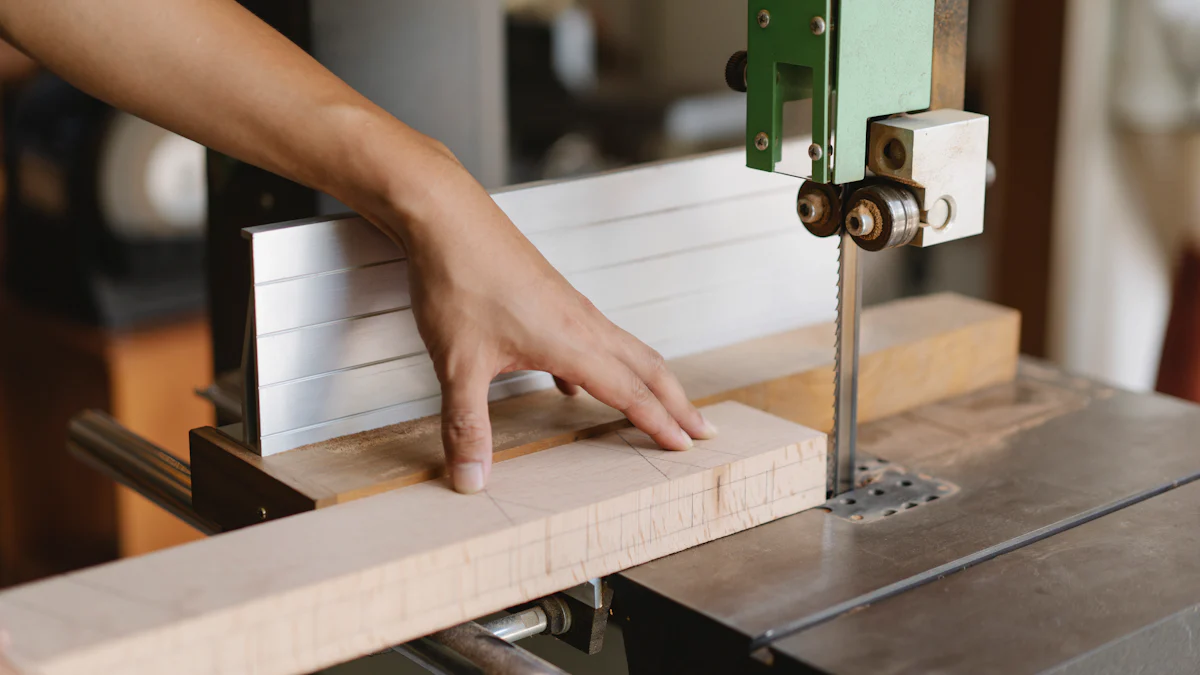
Sheetrock plays a crucial role in modern construction projects. This material provides a smooth and durable surface for walls and ceilings. North America uses an estimated 3.9 billion square meters of drywall annually, highlighting its widespread application. The right sheetrock cutting tools ensure precision and efficiency during installation. Proper tools prevent damage and ensure clean edges. Selecting the appropriate equipment enhances the overall quality of construction work, making it essential for professionals and DIY enthusiasts alike.
Essential Sheetrock Cutting Tools

Utility Knife
Features and Benefits
The utility knife stands as one of the most versatile sheetrock cutting tools. This tool excels in scoring the paper surface of drywall, allowing for a clean snap along the scored line. The utility knife features replaceable blades that ensure sharp cuts every time. Different types of utility knives, such as retractable and fixed-blade versions, cater to various user preferences and safety needs. The utility knife’s compact size makes it easy to handle and store.
Best Practices for Use
To achieve the best results with a utility knife, users should maintain a firm grip and apply steady pressure while scoring the drywall. A straightedge or ruler can guide the blade for precise cuts. Users should replace dull blades promptly to prevent jagged edges. For thicker drywall, the utility knife may require multiple passes to penetrate the gypsum core fully. Proper storage of the knife with the blade retracted enhances safety.
Keyhole Saw
Features and Benefits
The keyhole saw, also known as a jab saw, is ideal for intricate cuts in sheetrock. This tool features a pointed tip that allows users to start cuts without drilling pilot holes. The keyhole saw excels in creating tight shapes and openings for electrical outlets and fixtures. Its versatility extends beyond drywall, making it suitable for other materials as well.
Best Practices for Use
Effective use of a keyhole saw involves starting with a plunge cut using the pointed tip. Users should employ a sawing motion to follow the desired shape or outline. For circular cuts, such as those needed for light fixtures, the keyhole saw provides excellent control. Users should ensure the saw blade remains sharp to facilitate smooth cutting. Regular cleaning of the saw teeth prevents debris buildup and maintains efficiency.
Drywall Saw
Features and Benefits
The drywall saw is specifically designed for larger cuts in sheetrock. This tool features specially designed teeth that cut through gypsum board smoothly, minimizing dust and debris. The drywall saw proves invaluable for creating openings for doors and windows. Its ergonomic handle provides comfort during extended use.
Best Practices for Use
Users should begin by marking the cut area clearly on the drywall. A steady hand and consistent pressure ensure straight and accurate cuts. The drywall saw works best when used in a controlled sawing motion. Regular inspection and maintenance of the saw blade enhance its longevity and performance. Storing the saw in a dry place prevents rust and corrosion.
Advanced Sheetrock Cutting Tools

Rotary Tool
Features and Benefits
The rotary tool offers precision and versatility in sheetrock cutting tasks. This tool excels in creating detailed cuts and intricate designs. The rotary tool’s compact size allows for easy maneuverability in tight spaces. Various attachments enhance its functionality, making it suitable for different materials. The high-speed rotation ensures smooth and clean cuts on sheetrock surfaces.
Best Practices for Use
Users should select the appropriate attachment for the specific task. A firm grip on the rotary tool ensures stability during operation. Marking the cut area clearly on the sheetrock helps guide the tool accurately. Consistent pressure and controlled movements prevent damage to the material. Regular maintenance of the attachments extends their lifespan and maintains performance.
Oscillating Multi-Tool
Features and Benefits
The oscillating multi-tool stands out for its adaptability in sheetrock cutting projects. This tool accommodates various blade types, including those designed for plunge cuts. The oscillating motion minimizes dust production, ensuring a cleaner work environment. The Dremel MM435 Drywall Jab Saw attachment enhances its cutting capabilities. Compatibility with most oscillating tools makes it a versatile addition to any toolkit.
Best Practices for Use
Users should choose the correct blade for the specific sheetrock cutting task. A steady hand and consistent speed ensure precise cuts. Starting with a plunge cut eliminates the need for pilot holes. The tool’s oscillating action requires minimal force, reducing user fatigue. Regular inspection of the blades prevents wear and tear, ensuring optimal performance.
Specialized Sheetrock Cutting Tools
Jab Saw
Features and Benefits
The Jab Saw serves as a crucial tool among sheetrock cutting tools. This saw features a sharp point that allows users to plunge directly into drywall without needing a pilot hole. The aggressive tooth design ensures faster cutting through gypsum board. The handle provides comfort and protects hands during use. The USG SHEETROCK™ Jab and Keyhole Saw exemplifies these features with its 1.8mm thick blade, offering added strength.
Best Practices for Use
Users should start cuts by plunging the pointed tip into the drywall. A steady sawing motion helps achieve precise shapes and openings. Regular cleaning of the saw teeth prevents debris buildup. Maintaining a sharp blade ensures efficient cutting. Proper storage in a dry place prevents rust and prolongs the saw’s lifespan.
Track Saw
Features and Benefits
The Track Saw stands out among sheetrock cutting tools for its precision and efficiency. This tool features a guide rail system that ensures straight and accurate cuts. The track saw excels in making long, straight cuts on drywall panels. The saw’s design minimizes dust production, creating a cleaner work environment. The ergonomic handle offers comfort during extended use.
Best Practices for Use
Users should secure the guide rail firmly on the drywall surface. A consistent speed and pressure ensure clean cuts. Regular inspection of the blade maintains its sharpness and performance. Proper alignment of the track prevents deviations in the cutting line. Storing the track saw in a safe place protects it from damage.
Practical Guide and FAQs
How to Choose the Right Sheetrock Cutting Tools for Your Project
Factors to Consider
Selecting the right sheetrock cutting tools involves evaluating several factors. The type of project plays a crucial role in determining the appropriate tool. For intricate cuts, a keyhole saw or rotary tool offers precision. Larger projects benefit from the efficiency of a track saw. The material’s thickness also influences tool choice. Thicker drywall may require a more robust tool like an oscillating multi-tool. User experience level impacts tool selection as well. Beginners might prefer user-friendly options like a utility knife. Professionals often opt for advanced tools for faster results.
Common Mistakes to Avoid
Avoiding common mistakes ensures efficient use of sheetrock cutting tools. Users should not overlook the importance of sharp blades. Dull blades lead to jagged edges and uneven cuts. Proper maintenance of tools prevents performance issues. Incorrect tool selection can result in poor quality work. Choosing a tool based on project requirements is essential. Users should not rush the cutting process. Taking time to measure and mark accurately enhances precision. Over-tightening knobs or parts can damage tools. Careful handling preserves tool longevity.
FAQs on Sheetrock Cutting Tools
Common Questions and Answers
- What are the best tools for cutting sheetrock?
- Utility knives, keyhole saws, and rotary tools rank among the best sheetrock cutting tools. Each tool serves specific purposes based on project needs.
- How can users achieve clean cuts with sheetrock cutting tools?
- Maintaining sharp blades and using steady pressure ensures clean cuts. A straightedge or guide helps in achieving precise lines.
- Are there any recommended brands for sheetrock cutting tools?
- Brands like
GoldblattandDEWALTreceive high praise for their durability and performance. Many users recommend these brands for reliable results.
- Brands like
- What safety precautions should users take when using sheetrock cutting tools?
- Wearing protective gear like gloves and goggles is crucial. Ensuring a stable work surface minimizes accidents. Regularly inspecting tools for wear and tear enhances safety.
- Can sheetrock cutting tools be used for other materials?
- Some tools, like the oscillating multi-tool, offer versatility for various materials. Users should check compatibility before attempting different tasks.
Testimonials:
- Anonymous Amazon Customer praised a tool for its ability to cut drywall straight and clean, stating, “I have not been able to manually cut better than with this tool.”
- Another customer highlighted the time-saving aspect, saying, “So much time saved. And the cuts are perfect!”
- A user emphasized accuracy, noting, “This cutting tool helps with straight cuts, it is accurate and helps save time.”
Selecting the right sheetrock cutting tools ensures precision and efficiency in any project. Proper tools enhance the quality of work and prevent unnecessary damage. Applying this knowledge in real projects leads to improved results. A user shared a positive experience with a drywall cutting tool, highlighting its efficiency and accuracy. Users should understand each tool’s requirements and limitations to avoid issues. Readers are encouraged to share their experiences or ask questions. Engaging with others fosters learning and improvement in using sheetrock cutting tools.
See Also
Scooter Upgrades: High-Quality Parts for Maximum Performance
Discovering Diverse Sock Options for Both Genders
Mastering Winter Comfort with Plush Towel Sock Collection
